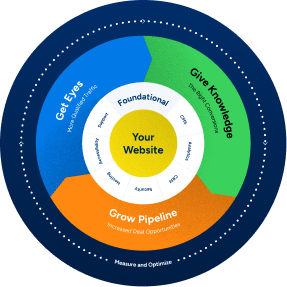There’s little in our digital lives more jarring than cruising along, happily scrolling through websites on our mobile device or desktop, skipping from link to link and then…the spinning circle that tells us “content is loading.” It might only be a second or two extra, but in the increasingly fast-paced digitally encoded world where we expect to be served up content on demand at the speed of right now, every millisecond a website takes to load is a chance the user loses interest and moves on to the next website.
Whether users are viewing your content on a mobile device or they are browsing your website sitting at their desktop computer, a website’s loading speed greatly impacts user behavior relative to your website and it’s important to understand what might be causing a slowdown in your website’s loading speed. In this blog, our team at GoingClear rounds up the usual suspects causing your website to load slowly, what our web design agency can do to alleviate these problems, and how fixing these issues can impact your SEO performance and improve your business’ bottom line.
Solutions for Common Loading Issues
We’re going to start out a little technical, because many of the issues that are slowing down your website’s loading time are on the programming side of things and can be handled at the design level by an experienced web design team. Let’s dive in.
Minimize Your Website’s Code and File Sizes
Your website looks the way it does because files behind the scenes contain instructions your web browser uses to assemble and eventually display information in a specified format. If your browser can read those instructions faster, ideally it could load faster. This is where a process known as minification comes into play. Minifying your page’s CSS, JavaScript, and HTML files optimizes the code in these files by removing characters added by programmers for the sake of clarity and readability for other programmers, but are unnecessary at the machine level. This includes commas, spaces, comments, and other formatting conventions. For more time-saving, you can also enable file compression and optimize images for use across.
Redirects, CDNs, Caching, and other Tricks of the Trade
Within the coding that makes up your website’s skeleton and guts, you can instruct it to behave in ways that take advantage of web page behaviors that will have an overall positive impact on your website’s load time. Using design tools built into browsers to analyze behavior across your site, you can analyze bottlenecks and improve server response times.
You can also instruct visitors’ browsers to save a copy of your website in local storage so that it can be accessed faster on subsequent visits. Other tools include content delivery networks, which allow your site to be stored in multiple servers across geographic areas, improving access times depending from where a user is accessing your webpage.
While all of that is going on, reduce the number of redirects to other pages that are required for your page to load so that your page isn’t waiting on external resources to load. The same goes with any external scripts in your JavaScript that are required to be imported before they can be run – these should be made to run asynchronously or after the page has been rendered by the browser.
Why A Streamlined Website Provides Better SEO Results
Getting your page to load as quickly as possible not only impacts user behavior, but it is also a factor taken into account when Google and other search engines deliver results to users. A Google employee was quoted as far back as 2010 and as recently as 2019 stating that website load speeds greatly impact search results and that certain standards have become considered best practices. For non-ecommerce sites, the target is 3 seconds, while ecommerce sites generally are expected to load as fast as 2 seconds.
The movement to streamline websites has really taken off with the shift towards mobile-first design in the last five years. This is a result of Google and other search engines actively prioritizing search results according to content found on the mobile version of websites. Many developers have thus started designing for smaller mobile devices as the default, and creating adaptive web pages that will shift structurally according to the screen upon which they are being used, negating the need to design and build multiple versions of the same page.
Beyond SEO, Slow Loading Times Impact Your Bottom Line
Search engine optimization is a great metric to strive for, but the proof of your website’s loading time really comes down to user behavior. It isn’t hyperbole when we tell you that every second counts. For your inbound marketing campaigns, it doesn’t do your marketing team any good to create pages and pages of content, and craft the perfect calls to action, if they’re directing potential clients back to a website that takes so long to load that clients abandon your website and move on to the next potential service provider or product.
Cloudflare, a service that protects websites from attacks and helps them to optimize performance, dug into the question of website speed’s impact on user behavior, and the results are shocking. Walmart improved their website’s load time by a single second and experienced a 2% increase in sales conversions. A company called Mobify effected a 100 millisecond improvement to their loading time and saw a 1.11% improvement to session-based conversions. What happens if your site slows down? The BBC found that for every second that they lost in load time, they could expect a 10% loss of total users on the site.
The Boston Web Design Agency That Understands the Need for Speed
Website loading speed can make or break your brand online. Based out of our offices in Boston. GoingClear’s team of B2B web design specialists understand how important page load times are, and how to maximize this metric using design and programming best practices. If you want to take your website to the next level and maximize your lead conversions without having to change any other aspect of your inbound marketing strategy, then reach out to our team and see why businesses across Boston trust our design agency with their livelihoods.

